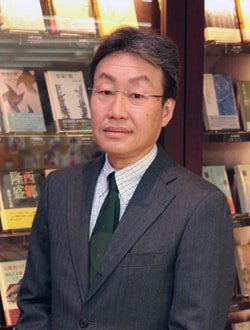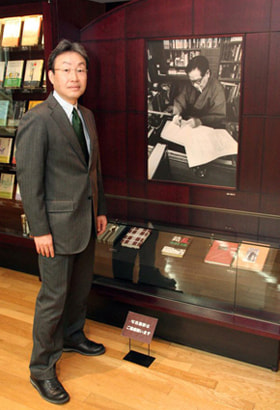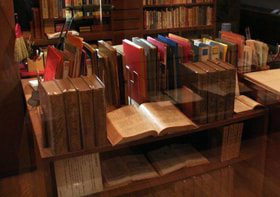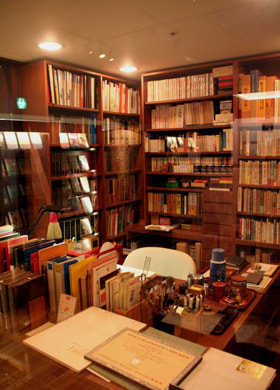
Fusaharu Tsurumatsu, an instructor at Ikenami Shotaro Memorial Museum, joined the Shinkokugeki theatrical company after graduating from School of Arts and Letters, Meiji University, majoring in Drama. He had served as an assistant producer of the company, dramatizing stories written by Ikenami Shotaro. After leaving the company, he had served as a private assistant of Ikenami for 15 years while working as a producer for the Japanese Dance Association Inc. and being involved in theater productions in Atsugi City. After the death of Ikenami, he worked to establish Ikenami Shotaro Memorial Museum (Taito City) and Ikenami Shotaro Sanada Taihei-ki Museum (Ueda City, Nagano Prefecture) while organizing materials and preserving Ikenami's works. After the opening of the museum and the hall, he has served as an instructor for both the halls, and, in various locations, introduced Ikenami's works in courses relating to Ikenami, as well as delivering lectures.
We talked with Fusaharu Tsurumatsu, an instructor at The Ikenami Shotaro Memorial Museum.
Tsurumatsu : Shotaro Ikenami died in 1990. The Ikenami family donated all materials on his literature, including books by him, his collection of books, his manuscripts, paintings by him and other various materials, to Taito City in 1992, two years after his death. Since he had many fans, the family intended to have at least a part of the materials open to the public. However, he was a writer with the common touch, and a large building would be unfit for him, so we thought it was better to display the materials at a section in a library. At that time, there was a plan to build new Central library in Taito City. Therefore, we decided to exhibit the materials on the floor of the library. Japanese words "Kinen-kan," are pompous, so we named it as "Ikenami Shotaro Kinen Bunko" or The Ikenami Shotaro Memorial Museum.

How was Onihei created?
"Onihei Hanka-cho" was originally titled "Asakusa - Onmaya Gashi" when it was first published in December 1967. At first, the title "Onihei Hanka-cho" was not used. "Asakusa - Oumaya Gashi" was written as a short story, and quickly acclaimed by an editor. Then, the editor asked Ikenami to write its sequels. In this way, Ikenami began to write "Onihei Hanka-cho" series, each of which was a complete story, from January 1968. In this series, the main character, Heizo Hasegawa, who served as a kind of special police of the shogunate in the mid Edo Period, and people around him are portrayed. What motivated Ikenami to write this series is as follows. There is a book titled "Kansei Choshu Shokafu" that is being exhibited here. This book contains all family lines of feudal loads and shoguns' direct retainers in the Edo Period. Ikenami studied the book and became most interested in Hasegawa's family line. Then, around 1955, he thought of writing about it some time in the future. He had been mulling over the story of Heizo Hasegawa, and finally wrote it 12 years later. It seems that the writing of the story led Ikenami to write a series of Edo stories.

Nine-volume set of "Kansei Choshu Shokafu" is put on in front of the reconstructed study room.
[Kansei Choshu Shokafu]
This book, first published in the Edo Period, was reissued in the Taisho Era. All family lines of the Tokugawa shogunate's direct retainers and feudal loads are contained. Heizo Hasegawa, described in this book, was an agent called "Hitsuke Tozoku Aratame-kata" in the mid Edo Period, whose job was to capture arsonists and burglars.
Study room
A part of Ikenami's study room in his house, where he wrote novels, is reconstructed. Since he wrote Japanese historical novels, many of his fans might imagine that he wrote them on a low table in a Japanese-style room. However, he actually worked in a Western style room. These desk and bookshelves are reproductions, but books on the bookshelves and various things on the desk, which were used by him when he was alive, are transferred from his house. It seems that the best place for him to write was a Japanese-style room, but, in his essay, he wrote that he occasionally stretched out on the floor if it was a tatami floor, got lazy and could not work hard, so he purposefully chose a Western style room. He really liked his study room. Other writers might have another workplace or write pieces in a hotel room, but he really liked to write novels in his study room. I think that 90% of his works were produced in his study room. He was a very methodical person, so things around his desk and materials were always organized. He was such a person.(continued in the next page)


Fusaharu Tsurumatsu, an instructor at Ikenami Shotaro Memorial Museum, joined the Shinkokugeki theatrical company after graduating from School of Arts and Letters, Meiji University, majoring in Drama. He had served as an assistant producer of the company, dramatizing stories written by Ikenami Shotaro. After leaving the company, he had served as a private assistant of Ikenami for 15 years while working as a producer for the Japanese Dance Association Inc. and being involved in theater productions in Atsugi City. After the death of Ikenami, he worked to establish Ikenami Shotaro Memorial Museum (Taito City) and Ikenami Shotaro Sanada Taihei-ki Museum (Ueda City, Nagano Prefecture) while organizing materials and preserving Ikenami's works. After the opening of the museum and the hall, he has served as an instructor for both the halls, and, in various locations, introduced Ikenami's works in courses relating to Ikenami, as well as delivering lectures.










